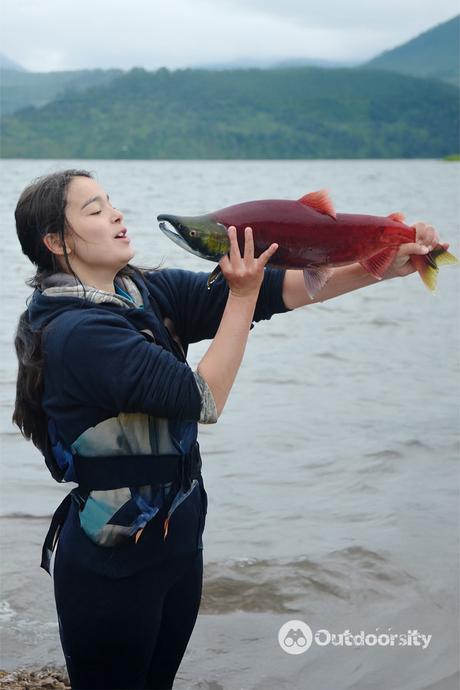Alaska is a fly fishing paradise that draws anglers from all over the world. With its vast wilderness and abundant waters, the Last Frontier offers some of the best fishing opportunities you'll ever find.
From mighty salmon runs to trophy-sized rainbow trout, Alaska's rivers and streams are teeming with fish just waiting for your fly.
You can fly fish in Alaska for five different salmon species, as well as rainbow trout, Arctic char, and grayling. Each species presents its own unique challenge and reward. The pristine waters and breathtaking scenery add to the experience, making every cast an adventure.
Before you pack your gear and head north, it's important to know when and where to go. Alaska's fishing seasons vary depending on the species and location.
Some of the best spots for fly fishing include the Kenai River, Kvichak River, and Brooks River. These waters are known for their impressive fish populations and stunning natural beauty.
Key Takeaways
- Alaska offers world-class fly fishing for salmon, trout, and other species
- The best time to fish depends on your target species and chosen location
- Proper planning and gear are essential for a successful Alaskan fly-fishing trip
Getting Started with Fly Fishing in Alaska
Alaska offers amazing fly fishing chances. You can catch many types of fish in beautiful spots. Here's what you need to know to start your Alaska fly-fishing trip.
Understanding the Basics
Fly fishing uses a light lure called a fly to catch fish. You cast the fly with a special rod and line. In Alaska, you can catch salmon, trout, and other fish this way.
Fly fishing in Alaska is different from other places. The water is often cold and fast. You need to learn how to read the water and spot fish.
Practice your casting before you go. A good cast helps you put your fly where the fish are. You can take lessons or watch videos to improve.
Choosing the Right Gear
You'll need some basic gear to fly fish in Alaska:
- Fly rod and reel
- Fishing line and leader
- Flies (lures)
- Waders and boots
- Warm, waterproof clothes
Pick a rod that matches the fish you want to catch. A 9-foot, 6-weight rod works well for many Alaska fish. Get flies that look like local insects or small fish.
Don't forget safety gear. Bring a life jacket and bear spray. A wading staff can help you stay steady in fast water.
Best Times of Year to Visit
The best time to fly fish in Alaska depends on what you want to catch. Here's a quick guide:
- May to June: Good for trout and char
- July to August: Peak salmon runs
- September: Late salmon and trophy trout
Summer (June to August) is the most popular time. The weather is nicer and days are long. But it's also crowded and expensive.
Spring and fall can be great too. There are fewer people and good fishing chances. The weather might be colder and wetter, so pack warm clothes.
Alaskan Fly Fishing Destinations
Alaska offers some of the best fly fishing spots in the world. You'll find pristine waters teeming with salmon, trout, and other prized catches. Here are three top places to cast your line.
Kenai River
The Kenai River is an iconic Alaskan fly fishing destination. You'll find it flows for 82 miles from Kenai Lake through the Kenai Mountains. This river is famous for its king salmon, but you can also catch silver salmon, sockeye salmon, and rainbow trout.
The best time to fish here is from May to October. In summer, you'll see sockeye salmon runs. Fall brings rainbow trout and Dolly Varden char.
You can wade in many spots along the river. For a unique experience, try driftboat fishing. This lets you cover more water and reach less-fished areas.
Remember to check local regulations. Some sections have special rules to protect fish populations.
Kodiak Island
Kodiak Island offers you a mix of saltwater and freshwater fly fishing. The island has over 100 streams and several lakes. You'll find all five species of Pacific salmon here.
The Karluk River is a top spot on the island. It's known for its king salmon and steelhead runs. You can also fish for sockeye and silver salmon.
Don't miss the chance to fish for sea-run Dolly Varden. These fish move between fresh and salt water, growing large and putting up a great fight.
Bear safety is key on Kodiak. Always be aware of your surroundings and follow local guidelines.
Bristol Bay

Bristol Bay is a fly fishing paradise. This area hosts the world's largest sockeye salmon run. You'll also find king salmon, silver salmon, rainbow trout, and Arctic char.
The Kvichak River is a standout in this region. It offers excellent fishing for trophy rainbow trout. These fish grow large feeding on salmon eggs and flesh.
Try the Nushagak River for king salmon. It's less crowded than some other spots but still offers great fishing.
Many lodges in Bristol Bay offer fly-out trips. These let you fish remote streams where few others go. It's a chance to experience true wilderness fishing.
Techniques and Tips
Mastering the right techniques and choosing the best flies are key to successful fly fishing in Alaska. These skills will help you catch more fish in Alaska's diverse waters.
Casting Techniques
When fly fishing in Alaska, you'll need to adapt your casting to different situations.
For rivers, try roll casting to avoid tangling your line in the brush behind you. This technique keeps your fly close to the water and works well in tight spots.
In open areas, use an overhead cast for more distance. Practice your double haul to cast farther in windy conditions, which are common in Alaska. This technique adds power to your cast by pulling the line with your non-casting hand.
For accuracy, try the reach cast. This helps you place your fly upstream of fish without spooking them. It's great for presenting your fly naturally in fast-moving rivers.
Fly Selection Strategies
Choosing the right fly is crucial for Alaska fly fishing success.
Match your flies to the local food sources and fish species you're targeting. For salmon, try egg patterns or bright streamers that mimic small fish.
When fishing for trout, use nymphs that imitate aquatic insects. Beadhead patterns work well to get your fly down in deeper water. Don't forget mouse patterns - they can be very effective for big trout in Alaska.
Always carry a variety of fly sizes and colors. Fish can be picky, so be ready to switch if one pattern isn't working. Ask local fly shops for advice on what's working currently.
Remember to adjust your fly choice based on the time of year and water conditions. In clearer water, use smaller, more natural-looking flies. In murky water, go for larger, brighter patterns to help fish see your fly.
Conclusion
Alaska offers amazing fly fishing chances. You can catch many types of fish in beautiful places. The rivers and lakes are full of salmon, trout, and other fish. You'll see stunning views while you fish.
Bring the right gear to stay warm and dry. Waders and good boots are a must. Try different fly patterns like egg-sucking leeches and flesh flies. They work well for Alaska's fish.
Fly fishing in Alaska lets you connect with nature. You'll make great memories. Plan your trip carefully. Choose the best time to go for the fish you want to catch. You can fish on your own or hire a guide. Guides know the best spots and techniques.
Alaska's fly fishing is world-class. You'll love the challenge and the beauty around you.

